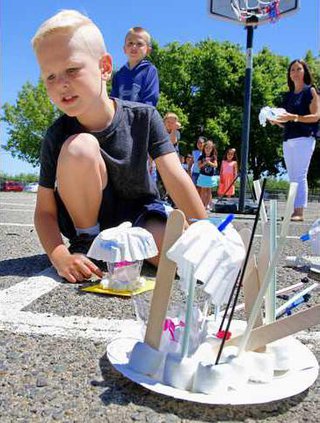Lincoln Van Houten tried to picture what type of structure would best keep an ice cube from melting on the warmest daytime spot at Colony Oak Elementary School.
The area southeast of the Ripon Unified campus had been determined earlier by his teacher Dana Phelps along with those from his kindergarten class.
“I don’t want my (toy) frog to go into the water,” said Van Houten, who made a model shade structure with popsicle sticks, masking tape, wiry pipe cleaner, and a coffee filter while housing the small plastic amphibian setting atop of a floating ice cube.
He and his entire class are part of the model Next Generation Science Standards from the Office of STEM (Science, Technology, Engineering and Math) at the San Joaquin County Office of Education, which also donated the materials for this project.
Together, they had to “make observations to determine the effect of sunlight on the Earth surface” according to this trial and error process of Thursday’s experiment.
“We weren’t anticipating the winds today,” said Phelps, who teamed up with Lissa Gilmore, SJCOE’s STEM Coordinator II, for this pilot program specifically for kindergarten students.
The scientists in them addressed the question: Which spot was the hottest because of the warmth of the sun?
As engineers, they had to solve the problem. In this case, they had to develop a shade structure to protect the toy frog on the melting ice cube.
“(Students) are learning how the sun heats the Earth’s surface,” said Phelps on her kindergarteners using their minds to built a cool shade apparatus designed to keep the ice from thawing from the noontime conditions.
“Students will have a chance to look on improving their (shade) design,” she added.
Clark Fullmer was another kindergartener who enjoyed this experiment. “I didn’t want the frog to go into the water so I didn’t want the ice to melt – I used a lot of tape (to keep) the model together,” he said.
The Office of STEM at SJCOE serves as a regional resource for teachers.
“This is teachers teaching teachers,” said Phelps of this first-ever partnership involving her and Gilmore, in this case, working together to develop curriculum for other kindergarten classes to follow.
Phelps and her students are the young scientists and young engineers of this pilot program, finding out what works and what doesn’t work.
“It’s amazing what they can do at age 5,” she said.
It’s all trial and error.
To contact reporter Vince Rembulat, e-mail vrembulat@mantecabulletin.com.





